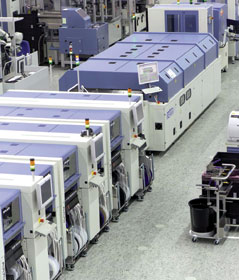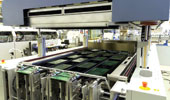

In this interview supplied by Rehm via its South African distributor Truth Electronic Manufacturing, Bernhard Erras, production planner of Siemens AG in Amberg, Germany, discusses the recent installation of a four-lane electronics production line for a part of the company’s Simatic-control PLC (programmable logic controller).
Confronted with the task of building a new SMT production line, including a repair workstation, with manufacturing capacity for 2000 PCBs per day, and with no extra floor space, the technologists at the facility had to find a way of using the available space as efficiently as possible.
In addition to thermal systems for electronics manufacturing, Rehm Thermal Systems also develops, engineers and supplies customer-specific solutions. The technical details of these solutions are dictated to a great extent by intended use, throughput quantities and cycle time.
Why four-track instead of traditional dual-track?
Bernhard Erras: Our company does not have much free space left, which is why we have to work with the existing lines, particularly here on the oven, since it is the longest element. Unfortunately we cannot expand our lines indefinitely. So in the case of Line 19, we were forced to make sacrifices when it came to length.
The soldering unit has a maximum capacity of 10 seconds per circuit board. At a length of 30 cm for the dual-track design, we would have needed a 10 metre long oven. This four-track system is 4,60 m long, plus 60 cm for the two shuttles at the inlet and outlet. For us, this meant the SMT line was nearly 50% shorter.
Which product do you manufacture with the new four-track system from Rehm, and what is the throughput and cycle time?
Bernhard Erras: We use Line 19 – as we call it – to manufacture input and output modules for the Simatic-control. The cycle time depends on what is being assembled in the product. However, in the case of these modules, it takes approximately 30 seconds in panels with 10 boards.
The capacity of the four-track oven is about 10 seconds per PCB panel. We work in three shifts, beginning on Sunday night at 11 pm until Friday evening or on Saturday too if needed.
What were the biggest challenges in implementing a four-track line?
Bernhard Erras: The biggest challenge after speaking with Rehm was the time factor. It turned out that although there were methods on the drawing board, there were still no final design plans that could be used for production with this four-track line.
The idea for implementing a production line with four-track system was the outcome of a conversation with Mr. Zeifang, technical director at Rehm. Just over six months had passed between the decision to invest in a new line and the actual installation.
During these six months, we had to work with Rehm in order to design and build the system and – among other things – to make it suitable for manufacturing.
...and are you happy with the outcome?
Bernhard Erras: Since commissioning took place at the plant, the system has been running in a 3-shift operation at full load smoothly and without problems. So far, we are very satisfied.
Why did you opt for Rehm in the implementation?

Bernhard Erras: Rehm has been our partner and supplier of reflow ovens for most of the company‘s 20-year history.
We use nearly all generations of Rehm systems here. It began with the V2 system and then we expanded to V4, V6, V8 and now the VXP generation. You could say that a longstanding as well as strategic partnership has developed over time.
The experiences in recent years have shown us that Rehm is capable of building these types of ‘special solutions’. The companies know each other well, which means they know each of the company‘s specific requirements as well.
From the very beginning, all parties realised that this was to be a line that will run in three shifts, starting on the first day. For this reason, we also wanted to minimise risk. And as mentioned above, this longstanding, strategic collaboration and partnership allowed us to realise the project together with Rehm. The risk of having to look for a new supplier for us would have been too great in the case of the special four-track oven project, which is still relatively new.
The four-track system has a new chamber opening concept with better accessibility. How has this system worked out when it comes to meeting day-to-day production needs?
Bernhard Erras: Operating the system actually works in the same way as with a dual-track system, which we are already using. The new design of the opening mechanism is useful when we have to work on or in the process chamber, such as for cleaning, maintenance or if we need to clear failures. This new opening design brings with it certain advantages for bringing up the top part of the oven at the same time.
We can access the process chamber from both sides, which also makes it easier to access all parts of the process chamber than we could in the past with the dual-track system. Using the current spindles, it is possible to achieve an opening height of almost half a metre, which allows us to access the hard-to-reach places in the process chamber more easily.
The waste collected during the first two months of three-shift operation is still within the acceptable range, despite a double loading in the frame. Compared to the two-track oven, there are even less failures. This suggests that there is less condensation and precipitation. We have installed two highly effective condensate traps in this system. As part of the weekly maintenance, the filter units are regularly replaced with clean ones.
The component can be replaced without interrupting the current production run, and the cleaning is done externally. The upshot is that this requires considerably less maintenance for our level of throughput.
Was Siemens involved in the redesign, and have all of the requirements been implemented?
Bernhard Erras: The idea of the four-track system originated during a discussion with Mr. Zeifang. Together, we then prepared a set of product requirements and functional specifications. Basically, it could be said that everything laid out in advance in terms of requirements such as system length, width, 10-second cycle times per board, cleaning concept as well as the design of the chamber opening mechanism, were all implemented within this short period of time.
This would not have been possible without the close, longstanding collaboration and cooperative goal-oriented implementation of the concept starting from the very first moment. We jointly discussed and tested all of the ideas, developments and advances together.
Are there any other projects where a four-track system could be used, or do you see it as a custom solution?
Bernhard Erras: It is difficult to answer this question this early in the game. I think there is additional potential for the electronics manufacturing facilities in Amberg to use four-track ovens. The output per assembly module increases, in turn increasing the productivity and therefore the productivity per cubic centimetre even more in the future.
If you look at the increasing complexity of printed circuit boards, compared to the increase in output of the lines, it will most likely be necessary to continue using longer double-track systems. We already have a couple of lines here in the EWA where the reflow soldering system is partly a timer. To manage the increasing throughput, we will need longer systems in the future.
Unfortunately, we do not have the necessary space for longer lines. Because we have to work with the existing width of the assembly machines, there is usually room for a wider but shorter four-track system. So I expect that even more four-track systems will be used in the future, at least here in the EWA – if nothing else, due to the positive experiences we have had with the first system.
At the current time, I cannot say whether our plant will be equally convinced by this concept. But I expect that this concept will prove itself in the long term. By the way, the four-track system on Line 19 uses exactly this Simatic ET 200S for production.
What is the general trend on the electronics market; what direction do you see both products as well as equipment changing?
Bernhard Erras: The products will certainly become more efficient, much like our new programmable controllers. The capacity per square centimetre on the individual circuit board will increase, ie, the assembling machines will develop in this direction due to the miniaturisation of the components relative to the production per square unit of area on a SMT line.
This means that the cycle in which I produce printed circuit boards at the end of this type of SMD line will most likely become shorter. Here in Germany or in the rest of Europe, we will be moving towards increasing output in the long term. Consequently, the machines have to be modified. We will not be able to make more production space available, which is why our lines have to become more efficient using the existing production space.
How do you see Germany as a place for electronics manufacturing in the future?
Bernhard Erras: We will certainly continue to be involved in high-end manufacturing and try to keep one step ahead of the world market in terms of technology.
For more information contact Truth Electronic Manufacturing, +27 (0)31 822 8555, [email protected]
| Tel: | +27 31 822 8555 |
| Email: | [email protected] |
| www: | www.truthelectronics.co.za |
| Articles: | More information and articles about Truth Electronic Manufacturing |
© Technews Publishing (Pty) Ltd | All Rights Reserved